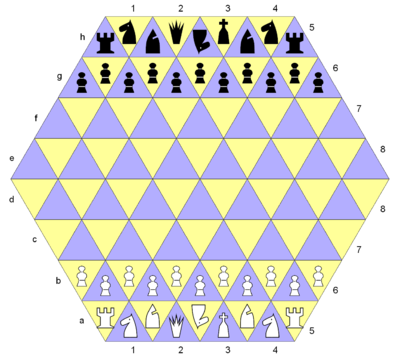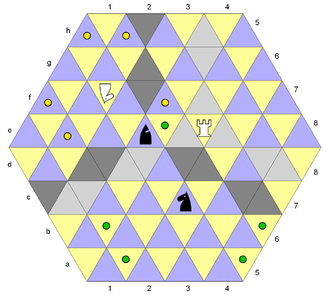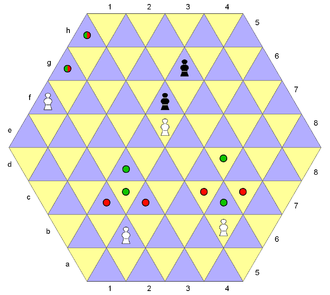
- Chess World Cup
- FIDE Grand Prix
- Olympiad
- World Championship
- List of strong tournaments
- List of world championships

- Checkmate patterns
- Chess openings
- Chess strategy
- Chess tactics
- Chess theory
- Endgames
- Pawn structure
- Problems/Compositions












 Triangular Chess gameboard and starting position
Triangular Chess gameboard and starting positionTriangular Chess is a chess variant for two players invented by George R. Dekle, Sr. in 1986. The game is played on a hexagon-shaped gameboard comprising 96 triangular cells. Each player commands a full set of chess pieces in addition to three extra pawns and a unicorn.
Triangular Chess and its variation Tri-Chess were included in World Game Review No. 10 edited by Michael Keller.
The starting setup is as shown. As in chess, White moves first and the object is checkmate. Other standard conventions apply as well, including castling, a pawn's initial two-step option, en passant, and promotion at the last rank. But the triangular geometry implies special move patterns for the pieces.
 The rook moves along cells in the diagram colored light gray; the bishop along cells colored dark gray; the black knight can move to green dots, or capture the rook; the white unicorn can move to yellow dots, or capture the bishop.
The rook moves along cells in the diagram colored light gray; the bishop along cells colored dark gray; the black knight can move to green dots, or capture the rook; the white unicorn can move to yellow dots, or capture the bishop.
 The white pawns can move to cells marked with green dots, or capture on red dots. The white pawn on f21 has no step straight forward, so advances one step at a time to promotion using its capture move, either moving or capturing. If the black pawn on g46 advances, the white pawn on e54 can capture it, for example: 1... e55 2. exf64 e.p.
The white pawns can move to cells marked with green dots, or capture on red dots. The white pawn on f21 has no step straight forward, so advances one step at a time to promotion using its capture move, either moving or capturing. If the black pawn on g46 advances, the white pawn on e54 can capture it, for example: 1... e55 2. exf64 e.p.Tri-Chess is a variation of Triangular Chess created by Dekle in the same year. The game is for two players and is the same as Triangular Chess in all respects except the moves of the bishop, rook, queen, and king are increased.